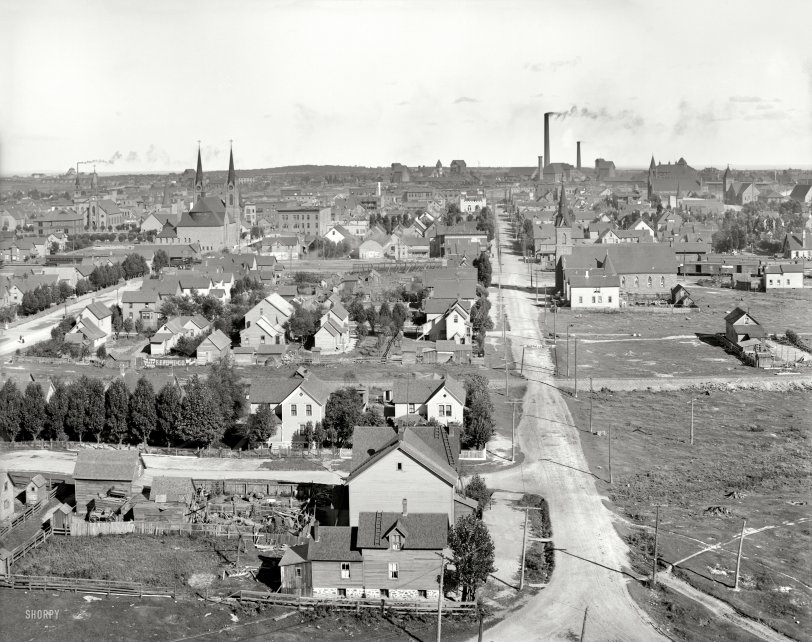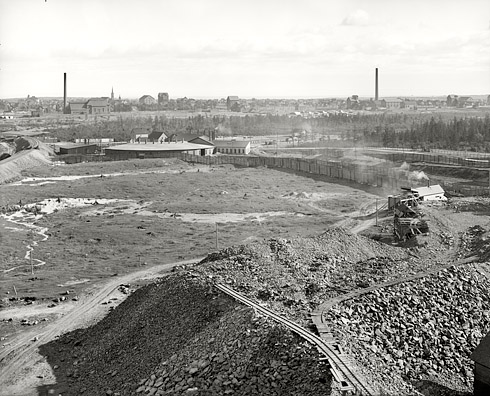


Framed or unframed, desk size to sofa size, printed by us in Arizona and Alabama since 2007. Explore now.
Shorpy is funded by you. Patreon contributors get an ad-free experience.
Learn more.

- Baldwin 62303
- Baldwin VO-1000
- Cold
- No expense spared
- Tough Guys
- Lost in Toyland
- And without gloves
- If I were a blindfolded time traveler
- Smoke Consumer Also Cooks
- Oh that stove!
- Possibly still there?
- What?!?
- $100 Reward
- Freeze Frame
- Texas Flyer wanted
- Just a Year Too Soon
- WWII -- Replacing men with women at the railroad crossing.
- Yes, Icing
- You kids drive me nuts!
- NOT An Easy Job
- I wonder
- Just add window boxes
- Icing Platform?
- Indiana Harbor Belt abides
- Freezing haze
- Corrections (for those who care)
- C&NW at Nelson
- Fallen Flags
- A dangerous job made worse
- Water Stop
Print Emporium
Calumet Continued: 1905

Calumet, Michigan, circa 1905. "The heart of the copper country." Note the "Railroad Crossing" sign over the street near the cow. This continues the righthand side of the previous post, made up of four 8x10 glass plates. In all, there are seven parts to this series. Detroit Publishing Co. View full size.
Contemporary Calumet
Some of these houses still stand, minus the outbuildings. At least they no longer have trains roaring through their back yards, but this is now a depressed town. This view looks North along Portland Street from the 11th street bend. There seem to still be industrial-looking storage buildings present at the camera site.
The cow's track is now missing
If you look closely at the aerial view on Google maps you can make out the remnants of the RR track path near where the cow was standing. It runs midway between 10th & 11th streets and parallel to them.
The remnants of the other tracks can be seen running between the two 9th streets depicted on the map. It is now labeled Hancock/Calumet Trail. The train station, or whatever it is now, can be seen just above Oak Street and to the left (behind) St. Paul the Apostle Church at the corner of Oak & 8th Streets.
I am trying to figure out how the photographer got such a high vantage point. Using Google Street view and looking West on Portland it doesn't look like the terrain rises sufficiently to provide the high vantage point that was used for the original image. Maybe he rented a "Cherry Picker", oh wait we are talking 1905 here. Maybe there was another smokestack at this end of Portland Street.
I can't wait to see the complete series of images.
[Click on the link! - Dave]
Other things unchanged
Boxcars still look the same now as they did then.
Railroad Crossing
I hope that cow knows how to read.
Remarkably unchanged
I was here a few years ago, and it still looks remarkably similar. Most of the brick buildings are still standing unchanged and I wouldn't be surprised if many of the wooden houses are still there, too.
We've got a cow on one street and what looks like a man walking a dog in the other.
The Extant Calumet Theater at Far Left
The left-most spire, directly in line with the smoking stack above it, was part of the clock tower to the extant, but now spire-less, Calumet Theater, at 340 6th Street.
http://www.calumettheatre.com/
This view shows the window details matching the 1905 image.
Where were the photos taken from??
Using Google Maps' street views, it's apparent that the area has a real hill shortage. Given the closeness of some houses, etc. my guess would be a balloon. Any better ideas out there?
[The view is from a shafthouse. Other parts of the mine are in the preceding sections of the panorama. The tailings under the shafthouse are in the last section (below). - Dave]

Some Churches Are Still Standing
The main road looks east down Portland Street. The closest church on the right is here
The big church closest to the front on the left is St. Paul the Apostle on Oak and 8th. There is a "new,", i.e., newer than 1905 train station west of the church in this image.
How the cow got out.
Did the cow get out when a tornado touched down in the back yard of the house in the foreground? The back of the house next door looks pretty bad as well. Holey moley, what happened?
Remedy for the cold outhouses
Chamber pots, anybody?
Besides, I wonder how well indoor plumbing would have worked during a harsh winter, anyway. After all, (central) heating at the turn of a valve or the throw of a switch for everybody and every room was also somewhat in the future.
[Central heating, whether convection or radiant from coal-fired furnaces and boilers, was well established by 1905. - Dave]
Thank God for indoor plumbing!
There are lots of privies and outhouses visible in backyards of the farmhouses in the foreground. It was probably not very comfortable in the winter with a state that has a lot of snow and a cold climate.
























On Shorpy:
Today’s Top 5